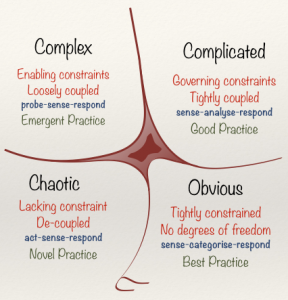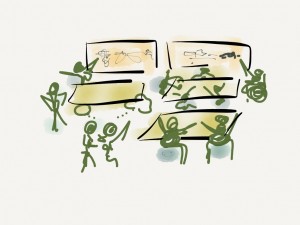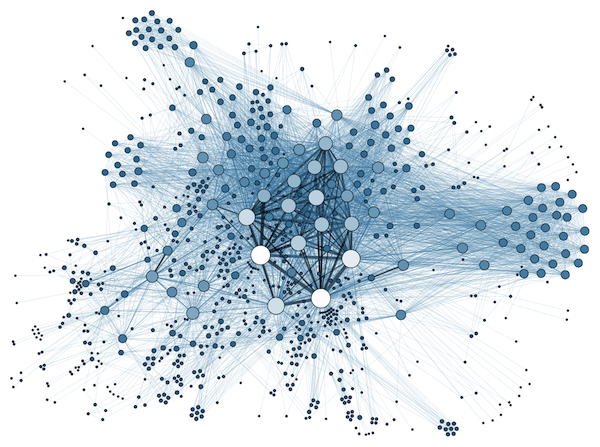 Over the past few years I have enjoyed being part of the MAFN Webinars. MAFN is the Mid Atlantic Facilitator’s Network. They offer both online and offline professional development gatherings. Last Friday, Amy Lenzo, Nancy Settle-Murphy and I were ostensibly the “presenters.” I think I want to shed that title. May I be done with presenting, please? And by the end, I realized it was a conversation with 36… so they are all presenters too!
Over the past few years I have enjoyed being part of the MAFN Webinars. MAFN is the Mid Atlantic Facilitator’s Network. They offer both online and offline professional development gatherings. Last Friday, Amy Lenzo, Nancy Settle-Murphy and I were ostensibly the “presenters.” I think I want to shed that title. May I be done with presenting, please? And by the end, I realized it was a conversation with 36… so they are all presenters too!
We designed the 90 minutes to minimize the presentation and maximize the engagement. I appreciated both Amy, Nancy and the great MAFN team of Michael, Dan, Fran and Meaghan — all ready to try new things and stretch ourselves.
We each had 5 minutes, then we were, as they say, off to the races. (You can see the five questions here in the PDF –> The Edge o fOnline Facilitation MAFN March2015 4 Blog.) In this case, it was a chat race. (At least it felt that way to some folks. I love it. Maybe I was a chat racehorse in my past life?) We then finished this first section with the following question:
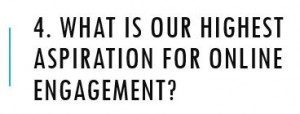
There were 36 participants (maybe a few less with a couple of duplicate log ins, etc.) and there was this amazing chat stream of ideas. So fertile and interesting. I wanted to share the key points.
- How can we network our intelligence to solve the huge problems facing the world/us?
- For on-line engagement to be as powerful and impacting as any face-to-face activity.
- Better connect with people all over the world.
- . . that it might be superior in some respects to face-to-face engagement
- People feel like they are in the same room even though they are not
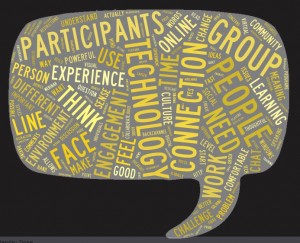
- Making deeper (non-trivial) connections with people at a distance
- For participants to feel energized and that they have had an experience
- To “level-set” the stakeholders’ understanding of the problem or challenge that all are facing.
- When the offline culture is not very participatory – using online/virtual to create exchange and relationships and change the culture a little bit.
- I think work has to meet human social needs. Online engagement is quite powerful because it can bring people together socially around quite microspecific topics and concerns
- People feel a sense of community, leave with decisions and catalyze action
- To introduce & discuss the change process in a positive energising atmosphere when some people are resistant to change
- Participants learn, understand, and feel connected to one another
- Superior to face-to-face in some ways because many people can “talk at once”. Appeals to some participants who might be hesitant to speak in a standard classroom
- Downplay power distances
- People actually “hearing” the words others were saying; a participant once exclaimed: We were using the same words but we did NOT mean the same thing
- People who are not technically minded can participate easily and are engaged
- Human connection across geography with powerful problem-solving
- Doing strategic planning for a global association on-line (different time zones, cultures, etc., in addition to all the normal human differences)
- Online engagement feels like in-person engagement
- Environments that are truly connected – where each of us feel deeply connected to ourselves – our own thoughts and bodies and full selves; to each other; to the natural environment and to the larger world we’re part of. Intimacy and Scale.
- That it truly engage and lead to the desired outcomes
- The technology is secondary – the community and results are foremost
- Create a level playing field so all can contribute to the best of their ability
- Speed and access to expertise
- Every voice contributes
- Making on-line meeting not just a one-off — so make it a practice that folks will get comfortable with over time (it won’t happen the first time, magically)
- The fact that the presenters can’t “keep u” means this is more participation than would be possible in person
- The challenge with online is that the human connection is mediated and distorted by technology. My aspiration is that the technology would feel invisible, or better yet, would be a catalyst for connection.
- Highest aspiration: hold onto the social aspect of learning
- My highest aspiration is connection. Task completion is secondary.
- Shared meaning … Having folks all proclaim: “I see, hear, & feel and understand.”
These 30+ people aren’t thinking small and I was encouraged and delighted. And from there, the conversation proceeded, mostly in chat and the rest of us with mic access sprinting to keep up became a cauldron of ideas and insights. The group segued from aspirations to questions and how to’s. Within the ideas there were also the meta comments about being challenged being in a text only environment, the pace, the sense of both richness and chaos. It is interesting to read back through the chat and try and pick out some key threads, and to discern where people are “coming” from with their insights. Some are clearly self-defined as trainers, others as facilitators. Some carry the context of the type of organization they work for, and others as consultants range across contexts.
Here are a few examples:
- What we notice and aspire too is obviously informed by WHAT we do. There were trainers in the group. People embedded in and in the context of organizations and their constraints. Consultants who ranged across contexts. This informs the type of “how-to” people sought or suggested.
- Everyone is interested in technology, but often in very different ways. Some want to know about the latest technologies. Others are interested in the impact of technology on our interactions. This quote really drew me in after someone talked about the way technology can distort our experiences: ” The presence of technology DOES change and effect the HUMAN experience and connection.” This segued into a conversation about how technology can/might not level the playing field. We are just beginning to really dig into these issues, and move beyond thinking of technology as a tool. I confess I’m getting tired of “what is the best tool for X” conversations and am ready for deeper explorations into the impacts of our technological environments, regardless of what tool is/isn’t available/acceptable/affordable! (Not to diminish those issues.) This is a great topper to this idea that one of my 36 co-presenters shared: “The way the hammer shapes the hand” — Jackson Browne, Casino Nation.
- We all struggle. Priceless: “My 20th century mind has been struggling to make meaning and order from the chaos of this group chat.” My observation? It is not related so much to age, but I don’t have data to support my hypothesis (says this 56 year old.) The issue for me from the stress of volume is what is lost, as one person wrote, without reflection. (Slow down, Nancy, slow down!) Clearly I’m not the only one with this issue: “I have not been building in enough reflection time in my webinars. I think it’s because I can’t tell when people have lost interest or when they are thinking. Could be an insecurity issue for me. Need to work on that!”
There was a lot more and I’m attaching a file with my semi-Sorted Chat Notes.
But here is the capper:
CAN WE DO THIS AGAIN NEXT WEEK PLEASE AND TALK ABOUT THE NEW QUESTIONS?
I love my 36 co-presenters! Co-creators! Co-labborators! Thank you, one and all. You help me…
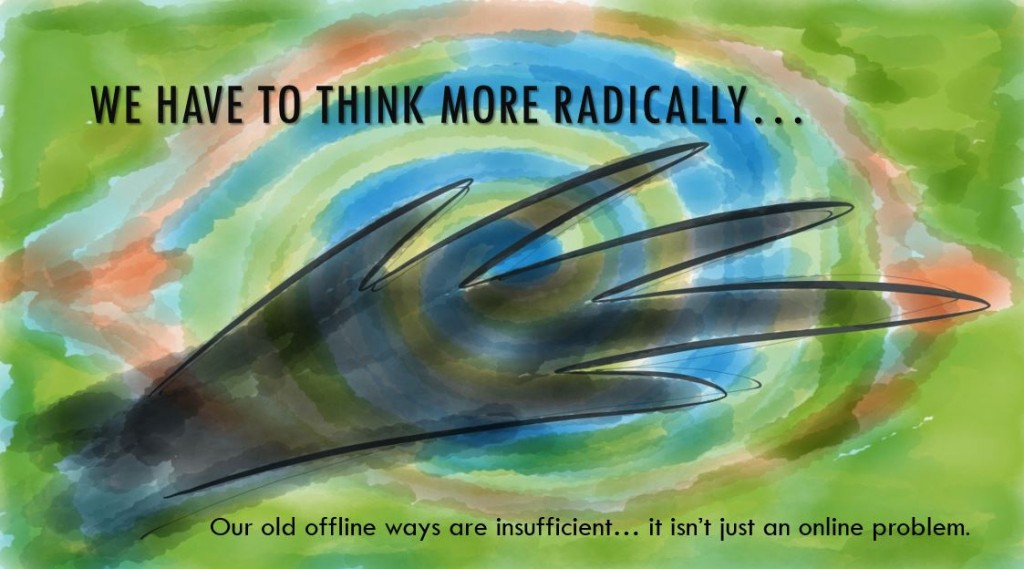
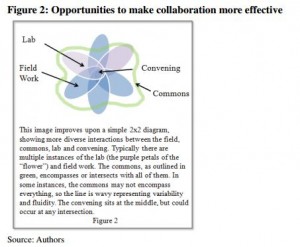 What feels like a long time ago and far far away, Rachel Cardone of Red Thread Advisors, Aldo de Moore of Community Sense and I decided to wrestle with some questions that were cropping up across our diverse work. We kept having clients say “we want to collaborate with our distributed teams,” and “what software should we buy.” Time and again, we saw so many of these initiatives fizzle out. It was our sense that we needed to look at the problem differently, with an appreciation for complexity and the diverse contexts across large international development organizations. That really interesting things were happening on the edges, but they didn’t seem to penetrate deeply into the organizations.
What feels like a long time ago and far far away, Rachel Cardone of Red Thread Advisors, Aldo de Moore of Community Sense and I decided to wrestle with some questions that were cropping up across our diverse work. We kept having clients say “we want to collaborate with our distributed teams,” and “what software should we buy.” Time and again, we saw so many of these initiatives fizzle out. It was our sense that we needed to look at the problem differently, with an appreciation for complexity and the diverse contexts across large international development organizations. That really interesting things were happening on the edges, but they didn’t seem to penetrate deeply into the organizations.